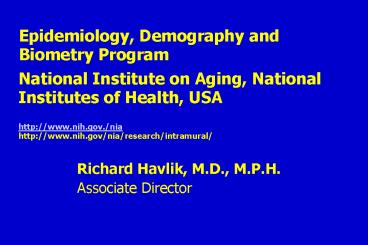Epidemiology, Demography and Biometry Program - PowerPoint PPT Presentation
Title:
Epidemiology, Demography and Biometry Program
Description:
... on aging and age-associated diseases and conditions using population-based ... Diseases & Conditions. Cognitive. Function & Dementia. EDB Program: Targets ... – PowerPoint PPT presentation
Number of Views:79
Avg rating:3.0/5.0
Title: Epidemiology, Demography and Biometry Program
1
Epidemiology, Demography and Biometry Program
National Institute on Aging, National Institutes
of Health, USA
http//www.nih.gov./nia http//www.nih.gov/nia/res
earch/intramural/
Richard Havlik, M.D., M.P.H. Associate Director
2
Learning Objectives
- To become familiar with the epidemiology programs
of the National Institute on Aging (NIA) - To understand the investigations being conducted
by the Epidemiology, Demography, and Biometry
(EDBP) Program, part of the Intramural Research
Program, (NIA) - To be aware of data resources available for the
study of the epidemiology of aging and
age-associated diseases
3
Performance Objectives
- Monitor appropriately and update knowledge
regularly concerning epidemiology programs at the
NIA - Become more knowledgeable about the epidemiology
of aging and age-associated diseases by accessing
information from the EDB Program, NIA - Begin to access data sets available at the
National Archive of Computerized Data on Aging
and use for relevant epidemiologic analyses
4
National Institute???? on Aging
5
(No Transcript)
6
Epidemiology, Demography, and Biometry (EDB)
Program Primary Mission
- To conduct research on aging and age-associated
diseases and conditions using population-based
epidemiologic and biometric methods
7
EDP Program Part 1
- Epidemiology, and Demography Office
- Chronic Diseases
- Aging Processes
- Environmental, Social, and Behavioral Factors
- Neuroepidemiology of Aging Office
- Dementing Processes
- Risk Factors for Dementia
- Other Neuropsychiatric Diseases
8
EDB Program Part 2
- Biometry Office
- Methods
- Statistics
- Data Management
- Geriatric Epidemiology Office
- Gerontological Issues
- Biomedical and Comorbidity Factors
- Genetic and Metabolic Factors
9
Utility of EDB Program Studies
- Elucidate the etiology of diseases by combining
epidemiologic data with information from other
disciplines.
- Evaluate the consistency of epidemiologic data
with etiologic hypotheses developed either
clinically or experimentally.
- Provide the basis for developing and evaluating
preventive new procedures and public health
practices.
10
Key Guiding Research Principles
Studies should
- Be platforms for hypothesis driven research
- Be population based to minimize bias and maximize
relevance - Be longitudinal in nature to minimize
cross-sectional biases - Address a wide range of psychosocial and
biomedical issues, including the incorporation of
emerging biological and genetic opportunities - Attempt to secure data from earlier in life to
assess long-term influences - Take advantage of racial diversity and unique
populations for investigation - Include opportunities for addressing very applied
questions
11
EDB Program Targets
Behavior\ Environment
Age-Associated Diseases Conditions
Cognitive Function Dementia
Physical Function Disability
Genetics
12
EDB Program Targets of Studies
Physical Function Disability
Cognitive Function Dementia
Genetics/ Poly- morphisms
Behavior/ Environ- ment
Diseases Conditions
?
?
X
?
?
X
?
?
?
X
X
?
X
?
X Primary Focus ? Secondary
13
EDB Program Major Studies
1990
2000
2010
1980
1985
1995
2005
EPESE
HAAS
WHAS
VSMA
HEALTH ABC
ACT
AGES - Hawaii (Diabetes)
AGES - Reykjavik (Iceland)
14
Established Populations for Epidemiologic Studies
of the Elderly (EPESE)
East Boston, 1982-83 Senior Health
Project (N3809)
Iowa 1982 85 Rural Health Study (N3673)
Epidemiology, Demography, and Biometry
Program (EDBP) National Institute on Aging (NIA)
New Haven 1982 Yale Health and Aging
Project (N2812)
North Carolina 1986-87 Piedmont Health Survey of
the Elderly (N4163)
15
EPESE Study Design
Sample
Total or random samples of community populations
of men and women age 65 and over
Number of Participants at Baseline
14,450
Follow-up
In-home interview 3-year intervals,brief
telephone contact intervening years. Blood work
and performance measures.
(Original sites 1982-83 to 1989) (Duke 1986-87 to
1993) Surveillance with Medicare and National
Death Index
16
Womens Health and Aging Study
Focus Causes and Course of Disability
- Screened 5000 for 1002 Disabled Older Women in
Community - Assessment of Baseline Disease-Disability
Associations - Follow-up for Course and Outcome over 5 years
17
Honolulu-Asia Aging Study
- A Study of Dementia in Honolulu Heart Program
Participants - 3734 Japanese-American Men Aged 70-90 years
- 25 Years of Prospective Data Available, Focused
on Cardiovascular Disease and Other Risk Factors - Completed Dementia Re-examinations at 3, 5 and 7
Years On-going Examination Cycle - Coordinate Methods with Studies in Japan, Seattle
18
Health, Aging and Body Composition(Health ABC)
Design
Clinical research study
3,075 persons age 70-79
Comparable numbers of women and men
Comparable numbers of whites and African-Americans
Free of ADL disability
Free of functional limitation
Outcome
New onset of functional limitation
Decline in performance, strength and endurance
Follow-up
Seven years with yearly examinations
19
Country-to-Country Activities
- Collaboration with
- MRI Study in 10 European Communities (study of
Cardiovascular Determinants of Dementia-CASCADE) - Honolulu-Asia Aging Study (dementia in
Japanese-American men) and with similar studies
in Seattle, Washington and Hiroshima, Japan
(Ni-Hon-Sea Study) - Aging project of the Veneto Region (PROVA Study)
using protocols similar to those of EDB Program - Italian Longitudinal Study on Aging (ILSA) has
cohort under observation since 1991
20
Planned Collaboration with the Iceland Heart
Association - Reykjavik Study
Scientific strategy
Characterize study participants with detailed
phenotypes for
Neurologic diseases (cognition, Alzheimers
and Parkinsons), atherosclerotic status,
diabetes and hyperglycemia, obesity and body
composition, and osteoporosis
Collect DNA and other biologic specimens for
molecular markers
Add unique risk factors to the database
birthweight, childhood weight, and dietary
factors
Test relevant candidate genes for genetic
susceptibility, gene-environment and gene-gene
interaction
21
National Archive of Computerized Data on Aging
(NACDA)
- Mission is to advance research on aging by
helping researchers gain access to archived data
sets. - Located at the University of Michigan and is a
project of the Inter-university Consortium for
Political and Social Research (ICPSR) - For further information http//www.icpsr.umich.ed
u/NACDA































